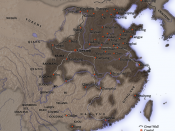Brutal, superior, powerful great leaders, describes some characteristics of the emperors who ruled the states Qin and Han. They attributed to the rise and fall of each empire politically, economically, and socially. The rise and fall of an empire is also contributed by the emperors who rule over each dynasty (the Qin and the Han). In addition new technology and developments influence the rise and fall of the empires to.
What really lead to the rise of Qin conquering China and the fall of the empire? Politics took a big role in the rise and fall of the Qin dynasty. Between 402 B.C.E and 201 B.C.E the large states of China were fighting to gain control over the entire area during the period of the Warring States. The Qin dynasty was the only state that managed conquering the other warring states, unifying China for the first time. At that time Qin was considered a powerful state, mainly due to its powerful army which utilized new technology in combat, and was made up of horse archers (cavalry).
Shi Huangdi (first emperor) at the time was the emperor of Qin. He was a cruel, but efficient ruler who brought China under a single overbearing rule. He stressed central authority. "Shi Huangdi knew that the end of aristocratic rule would solve China's dilemma. Aristocrats that were gaining power over feudal provinces were sentenced to appear at Shi Huangdi's court and leave their states. Once this event occurred the emperor then appointed bureaucrats to rule the provinces" (Stearns, et. al., p. 38). The rise of the Qin dynasty was at its highest power when Feudalism (military based government) was overrun by a bureaucratic government (hierarchical based government with a system of ranking and organization of people/things). The fall of Qin dynasty was...


